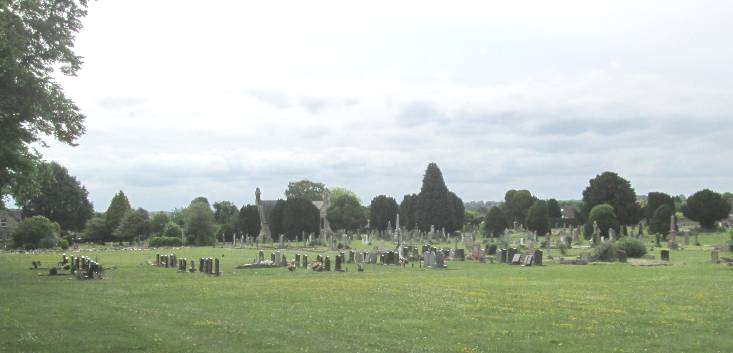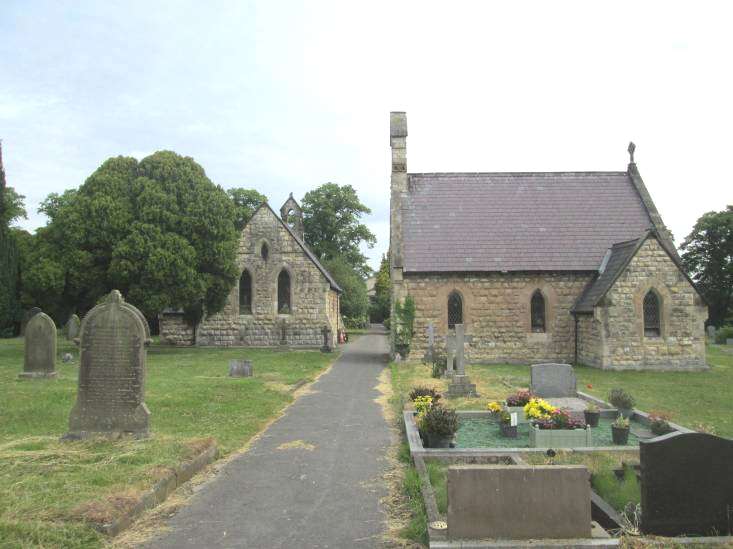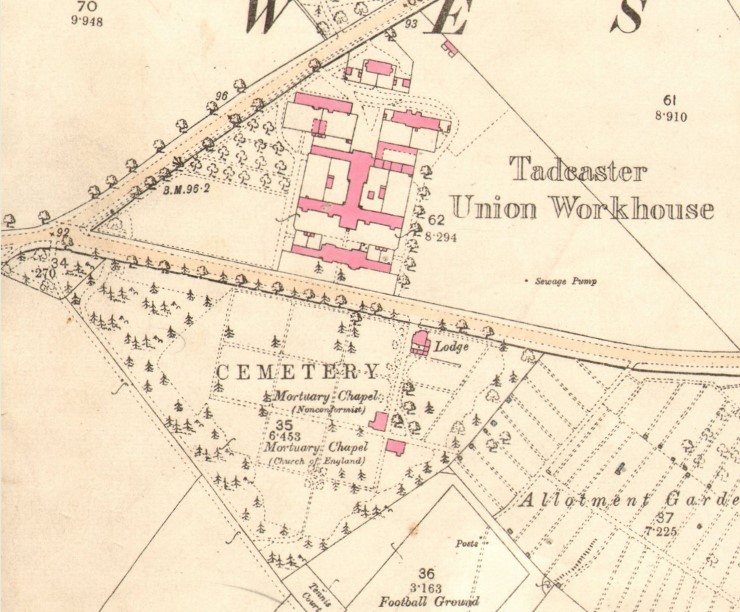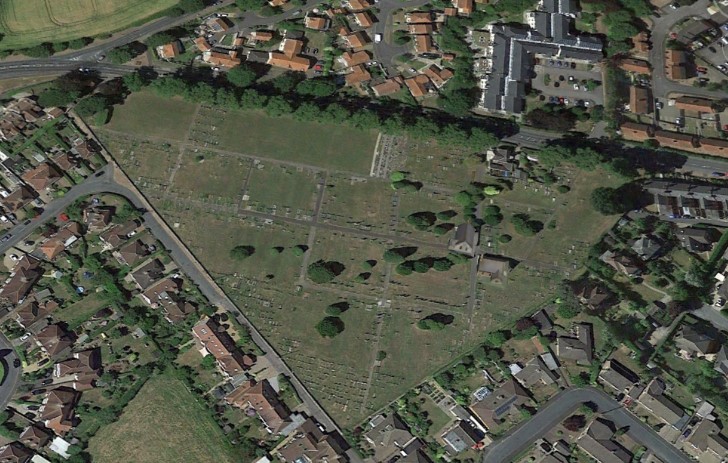This article is reproduced with kind permission of the Tadcaster Historical Society
The Tadcaster Cemetery
The Boston Spa News of Friday 30 November 1877 printed the following article:
“Consecration of Tadcaster Cemetery
His Grace the Archbishop of York visited Tadcaster on Monday for the purpose of consecrating that portion of the cemetery set apart for the burial of those connected with the established church.
The ceremony, which commenced at 3 o’clock only occupied for about 15 minutes and consisted of perambulating a portion of the southern part of the ground, prayers adapted to such occasions being read by Archbishop. The burial ground is situate about a quarter of a mile to the west of the town on the Leeds Road, and comprises altogether, including the portion set apart for nonconformists, six and a half acres of land which has been laid out in the usual manner. Two chapels, one for the Church of England, and the other for non-conformists, have been provided.
They are built with Bramham Moor stone and the roofs are slated. There is also a handsome lodge for the sexton at the entrance to the cemetery. On the north and west sides, the burial ground is
enclosed by a stone wall and the other side by a quick-wood fence. The land was purchased from Lord Londesborough’s trustees at a cost of £700.
Previous to the formation of the cemetery the church yard was used for interment but that place having become full, it was closed by order from the Secretary of State, of course with the
reservation of existing privileges. The cemetery has been licensed for interments since January 1876, and from that time there have been 83 persons interred therein. The whole works have been
carried out under the supervision of the Burial Board. Altogether the formation of the cemetery has cost £2800.”
This all sounds very straight forward and worthy, but there is quite a story behind the provision of the Cemetery. In 1873, the Burial Board began looking for land suitable for the new Cemetery after it was realised that the Church yard was becoming full. Lord Londesborough, the major landowner at the time, had been approached with a proposal to purchase some land and three separate fields had been suggested by the Board. Of these three fields, Lord Londesborough’s Trustees were only prepared to sell one, which is the current site of the Cemetery.
The piece of land was 6 acres, 2 roods and 16 perches (just over 6½ acres) in area and a price of £103 per acre was agreed in May 1873. However, the Burial Board had no money and had to apply for the money from the Vestry, the Church Authorities in Tadcaster. A sum of £2000 was requested for the purchase of the land and provision of two chapels and the sexton’s cottage.
By the 27th of September, the Burial Board had decided that only four acres of land was required and Mr Bromet, the clerk to the Burial Board, and a solicitor, had agreed to take the remaining part of the 6½ acre field at the price per acre agreed for whole field. The Burial Board then asked that the Trustees of Lord Londesborough should convey the whole field to Mr Bromet, on the understanding that Mr Bromet would immediately convey the portion of the field required for the Burial Ground to the Burial Board.
So far, so good, but...

Tadcaster Cemetery Today
The Boston Spa News of Friday 19 December 1873 reported:
“THE BURIAL BOARD OF TADCASTER. IMPORTANT MEETING OF RATEPAYERS. A Vestry meeting of the ratepayers of Tadcaster, was held on Friday evening, to take into consideration the recent acts of the Burial Board, in selling to the clerk two acres of land purchased as a site for a burial ground, and their actions in allowing the whole to be conveyed to him. The Rev. Theophilus Clark, the vicar, occupied the chair, and there was a numerous attendance of ratepayers, including nearly all of the members of the board.”
It seems that the legality of some of the proceedings of the Burial Board was called into question by some of the parishioners, who thought that they (the Burial Board) had allowed some of the land purchased for the board by the Clerk to be re-purchased by him, without sufficient power having been lodged in their hands by the Vestry. The major objection was raised by Mr Benjamin Blaydes Thompson, another solicitor of Tadcaster. He had decided that the decision by the Burial Board that only four acres was required was taken illegally. The Burial Board had not called a Vestry meeting to agree the amount of land required, and the Vestry meeting should have given approval for any surplus land to be sold. He was particularly aggrieved that, between the agreement to buy the land from Lord Londesborough and having the money to complete the deal, the land had been sold to Mr Bromet. Mr Thompson had taken it upon himself to consult a QC on the matter, who basically agreed with him. Mr Thompson then proposed that the Burial Board had no authority to dispose of any part of the field.
The subsequent discussion reported in the newspaper was wide ranging. One opinion was that any surplus land should be offered at auction. Mr Ingleby, the mill owner, expressed the opinion that the whole premise of this meeting was strange
and suggested that it was purely spite by Mr Thompson. Another thought that Mr Bromet had behaved in a very decent fashion and had saved the ratepayers considerable expense. There was extensive discussion about the quantity of land
required for burials for a population of about 3000 people. But the gist of Mr Thompson’s objection was that Mr Bromet had purchased this land and was profiting from it at the ratepayers’ expense. Mr Bromet refuted this and stated that he and the Burial Board had behaved openly and honestly at all times. At the end of the meeting, a vote was taken on the resolution that the Board had no authority to dispose of any of the land. By a show of hands, 23 agreed and 10 disagreed.

The Two Chapels in the Cemetery
On the 9th of January 1874, a meeting of the ratepayers of the Parish of Tadcaster was held in the Town Hall. The purpose of the meeting was to reconsider the decision come to at the meeting on the 12th December. The two solicitors, Mr Bromet and Mr Thompson, then debated the legality of the December meeting, with Mr Bromet showing that the meeting had not been correctly advertised so that many interested ratepayers had not attended.
He also held that the “show of hands” vote was illegal since many ratepayers had several votes each, due to the value of their property, so that counting a single vote per person had distorted the result.
Mr Thompson was reported to say that the outcome from the previous meeting would not change and allowed this meeting to continue. The course of action of the Burial Board was explained again. Prior to the Londesborough land sale, which took place in July 1873, Mr Bromet had purchased the six and a half acre field on behalf of the Burial Board. He had also purchased some other land on his own behalf. The six and a half acre field was not the first choice of the Burial Board but a four acre square could be marked out within the field for the burial ground. However, Mr Bromet had offered part of the six and a half acre field and part of his other new purchase, which would then be close to the position that the Burial Board had originally preferred. The proposed plans were passed around at the meeting.

1893 Map Showing the Cemetery and the Workhouse
Mr Thompson objected to this by saying that the triangular portion of the six and a half acre field would be preferable. Mr Bromet pointed out that this would mean that every funeral would have to travel twice as far as need be and that every funeral would come in front of the Workhouse, which the inmates would take as a punishment.
Mr Shann pointed out that there were only two windows at the Workhouse from which a funeral could be seen. Mr Dixon preferred a piece of land closer to the town and suggested that the whole of the six and a half acre field should be taken with
part turned into a recreational ground – which was met with amusement at the thought of a recreation ground next to a cemetery.
The Rev E H Brooksbank was against the proposed position since it would be in full view of the poor house. He then stated that they should have the whole piece since the Doncaster Burial Board was already looking to increase the size of their cemetery. However, he was concerned that the whole area would be an eyesore and should be surrounded, as per the regulations, by an eight foot high wall. He also stated that there could be no graves within fifteen feet of such a wall, which would reduce the useable size of the cemetery. There was then another long debate about the size of cemetery required by the town.
The Boston Spa News continues: “Mr VAVASOUR moved "That a burial ground of four acres is sufficient for the requirements of the parish; that the vestry adopt the site selected; that all the arrangements made by the board be approved of and sanctioned by the vestry; that the board be requested to take such steps as may be necessary for carrying into effect such arrangements, and that all previous resolutions of the vestry inconsistent therewith be rescinded." He remarked that it seemed to him they had got the very piece of land which was at first proposed to be acquired for the cemetery, and which Lord Londesborough's trustees objected to sell them. It was, according to what had been read to them upon authority, quite sufficient for the purpose, indeed there was more than half as much again as was required. It seemed to him to be a suitable site, and there certainly was an objection to its facing the workhouse. If the other piece was elected, every funeral would have to pass there twice; and he believed that the board in London would object to its facing the Union [Workhouse]. Then it seemed to be a great advantage to have the burial ground as near as possible to the town, and the site proposed was the nearest suitable place that could be obtained. The piece, which was proposed, was much more symmetrical and nicer than a three-cornered piece, which would be more difficult to keep up hereafter. As to the land being resold, Mr Bromet had obliged the town, and it was only fair that in return the rest should be sold to him rather than anyone else. He did not charge them anything for it, but paid what it had cost, and simply took from them the surplus land they happened to have. As to the proposition to have the land sold by auction, if they did so, then they did not know what they would get for it, the price might be more than Mr Bromet gave, and might be less, there always being the risk."
After much more discussion, the votes were counted with Mr Thompson’s motion that the Burial Board had exceeded their remit receiving 83 votes and Mr Vavasour’s amendment that the Burial Board was right receiving 105 votes. But this was still not the end of the story. Mr Thompson then wrote to the Editor of the Boston Spa News casting doubt on the validity of the vote. He claimed that several ratepayers from Hazlewood were not eligible to vote since the Chapel at Hazlewood was a private Roman Catholic Chapel and without these votes, his motion would have been carried.
The troubles rumbled on to the 2nd of April 1874 when a Burial Board meeting was held to appoint three rate payers to vacancies on the Burial Board. Following the successful election, it was proposed that the Board should agree to pay the Clerk, Mr Bromet, for his services for the year. This was agreed to, except that Mr Thompson claimed that Mr Bromet should recompense the Board by a suitable amount. The latest problem seems to be that, during all of the discussions about the legality of the purchase of the land for the Cemetery, the Tadcaster and Halton Dial Turnpike Trust had discontinued and had offered the Toll-bar House and Garden to the nearest landowner for purchase. The Toll-bar House was at the junction of Leeds Road, Station Road and just to the town side of Garnet Lane. The nearest landowner had been Mr Bromet, who was legally the owner of the land for the Cemetery but who claimed he only held the land in trust for the Burial Board. Mr Bromet had subsequently bought the Toll House and garden and had not offered it to the Burial Board. Mr Thompson stated that the Toll House would be suitable for the sexton and should be included in the Cemetery. Mr Bromet pointed out that the Burial Board had been forced to take more land than they wanted already and did not need or require any more. The house was at the wrong end of the Cemetery to be useful. Also, at least half of the house needed to be demolished since it encroached on the road.
The meeting then degenerated into another argument about how much land was needed for the Cemetery before voting to pay Mr Bromet the salary he was due.
By April 1875, Mr Thompson had become the clerk to the Burial Board. In November 1877 the Cemetery was consecrated by the Archbishop of York. The name of Bromet as a respected solicitor in the town continues to this day. However, Mr Thompson’s story was rather different. The Boston Spa News of 8th July, 1881, reported on the first meeting of the creditors of Benjamin Blaydes Thompson, solicitor of Tadcaster, who had liabilities of £4,075 10s 9d and assets of £344 3s 2d.
He is last heard of in the Leeds Mercury of 29th October 1881:
"BENJAMIN B. THOMPSON's LIQUIDATION.-A general meeting of the creditors of Benjamin Blaydes Thompson, of Tadcaster, solicitor, was held yesterday afternoon, at the office of Mr. W. Wilkinson, St. Helen's square, York, solicitor, for appointing a time for the close of the liquidation, and for other purposes. Mr. Blackburn, of The Mount, York, occupied the chair, and there were several other creditors present. After the notice convening the meeting had been read, and before proceeding to the consideration of the first resolution, one of the creditors proposed that the debtor be requested to retire. The latter refused to do so, and although repeatedly advised by his solicitor to withdraw, he persisted in remaining. Thereupon Mr. Blackburn vacated the chair, and was followed by the rest of the creditors. The meeting was then brought to an abrupt and unexpected termination. The debtor subsequently consented to leave the room but the creditors having left the office, the business could not be proceeded with.”

Tadcaster Cemetery Today Aerial View